Congratulations! I know it's just a number but it's a pretty awesome milestone regardless.And finally some good news: For the last 2 days now I have dipped below the threshold of "morbid obesity" when based on body fat:
You are using an out of date browser. It may not display this or other websites correctly.
You should upgrade or use an alternative browser.
You should upgrade or use an alternative browser.
From >450 to <160 lb by 2022
- Thread starter Err2
- Start date
Err2
New member
Saturday progress report:
Time Period __ Weekly Avg Weight __ Weekly Avg BF% __ Daily Avg Calories
2 weeks ago: _______ 287.7 __________ 42.5% _________ 1439
1 week ago: ________ 287.5 __________ 41.8% _________ 1412
last week:. _________ 284.7 __________ 40.0% _________ 1441
My 2 week average weight loss was 1.0% - half of my 2% target. My 2 week average body fat loss was 2.5% - 2 1/2 times my ~1% I target. No dietary changes are planned for this week...
While my weight hasn't changed too dramatically, I am seeing significant changes visually. My clothes have gone from baggy to dress-like to "don't bend over or they'll fall off." I can't see the point in acquiring a temporary new wardrobe, especially during quarantine, so I've been trying to teach myself how to operate a sewing machine in order to alter my old clothes to get me through the next month or two. So far things look okay from 15 feet, but a close observer will spot crooked stitches and hems...
Time Period __ Weekly Avg Weight __ Weekly Avg BF% __ Daily Avg Calories
2 weeks ago: _______ 287.7 __________ 42.5% _________ 1439
1 week ago: ________ 287.5 __________ 41.8% _________ 1412
last week:. _________ 284.7 __________ 40.0% _________ 1441
My 2 week average weight loss was 1.0% - half of my 2% target. My 2 week average body fat loss was 2.5% - 2 1/2 times my ~1% I target. No dietary changes are planned for this week...
While my weight hasn't changed too dramatically, I am seeing significant changes visually. My clothes have gone from baggy to dress-like to "don't bend over or they'll fall off." I can't see the point in acquiring a temporary new wardrobe, especially during quarantine, so I've been trying to teach myself how to operate a sewing machine in order to alter my old clothes to get me through the next month or two. So far things look okay from 15 feet, but a close observer will spot crooked stitches and hems...
alligatorob
Respected Member
That is great! A better measure than the scales, I believe. I understand the not buying new dress clothes dilemma, I shrunk out of mine months ago and they are long gone now, thankfully. I no longer have sports coats, slacks or a suit, and don't have much need for them. However now that I am in maintenance I am thinking about it. You will get here too, sooner than you might think.My clothes have gone from baggy to dress-like to "don't bend over or they'll fall off." I can't see the point in acquiring a temporary new wardrobe, especially during quarantine, so I've been trying to teach myself how to operate a sewing machine in order to alter my old clothes to get me through the next month or two.
Err2
New member
Yeah, it would be nice to use the quarantine to acquire enough skill to be able to make everyday clothing fit well rather than always hiding under baggy clothes (or accepting the wait for & expense of custom tailoring). I have short legs (~28" inseam), a longer torso (extra tall tee-shirts), and have always had larger quads and biceps so nothing ever fits well off the rack.
And on that note, my original goal of 160 lbs @ 15% body fat is looking a bit less practical for me. At my current projections, I'm more likely to be 167-170 lbs @ 15% body fat and would have to be closer to 12% body fat to hit 160 lbs. I'll shoot for that, 160 being the top end of "normal" for my height, but 12% body fat may be impractical with my excess skin. Assuming it is still healthy, I'd much rather maintain enough strength to be able to throw around 100 lb bales of hay than fit a chart in some city slicker's textbook.
I'm still a year away so the projections will likely change, but it is something I'm keeping in mind...
And on that note, my original goal of 160 lbs @ 15% body fat is looking a bit less practical for me. At my current projections, I'm more likely to be 167-170 lbs @ 15% body fat and would have to be closer to 12% body fat to hit 160 lbs. I'll shoot for that, 160 being the top end of "normal" for my height, but 12% body fat may be impractical with my excess skin. Assuming it is still healthy, I'd much rather maintain enough strength to be able to throw around 100 lb bales of hay than fit a chart in some city slicker's textbook.
I'm still a year away so the projections will likely change, but it is something I'm keeping in mind...
Cate
Long term member
It’s smart to reassess goals as you go & I love this-
Assuming it is still healthy, I'd much rather maintain enough strength to be able to throw around 100 lb bales of hay than fit a chart in some city slicker's textbook.
Keeping an open mind about your final goal sounds sensible. No use worrying about something you can't really predict yet.
Being able to do standard alterations is a highly useful skill and much easier than what you're doing right now, which is basically recontructing half the garment.
Being able to do standard alterations is a highly useful skill and much easier than what you're doing right now, which is basically recontructing half the garment.
alligatorob
Respected Member
I agree with the others, adjusting your goal as time goes along makes sense. For a long time I thought my original 160 goal was not realistic, but now I am a little below it (most days). You will know when you get there.And on that note, my original goal of 160 lbs @ 15% body fat is looking a bit less practical for me. At my current projections, I'm more likely to be 167-170 lbs @ 15% body fat and would have to be closer to 12% body fat to hit 160 lbs. I'll shoot for that, 160 being the top end of "normal" for my height, but 12% body fat may be impractical with my excess skin. Assuming it is still healthy, I'd much rather maintain enough strength to be able to throw around 100 lb bales of hay than fit a chart in some city slicker's textbook.
I used to haul hay in high school, but I don't think the bales were 100 lbs, probably closer to 75. Still loading a hay wagon was a pretty good work out. The gym is a lot cleaner...
Err2
New member
I used to haul hay in high school, but I don't think the bales were 100 lbs, probably closer to 75. Still loading a hay wagon was a pretty good work out. The gym is a lot cleaner...
Yeah, dry hay on a sweaty neck always rubs me the wrong way, but I do enjoy the feeling of accomplishment when closing the doors on a stocked barn. Out here traditional bales are 3-string and 90-140 lbs, but we're increasingly seeing 2-string 40-75 lb variants. The later seem to cost a bit more per ton and visually remind me of the 1.5qt "half gallon" ice cream containers now filling store freezer isles, but I hear they are the norm back east.
Lingwo
Active member
Hey Err2,
I just caught up on your thread, that's an amazing accomplishment. I also love Excel sheets, so I'm taking some inspiration from you. I just started my weight cut yesterday.
I know at one point you were using the Navy method to calculate BF% - is that still the case?
I just caught up on your thread, that's an amazing accomplishment. I also love Excel sheets, so I'm taking some inspiration from you. I just started my weight cut yesterday.
I know at one point you were using the Navy method to calculate BF% - is that still the case?
Err2
New member
Hey Err2,
I just caught up on your thread, that's an amazing accomplishment. I also love Excel sheets, so I'm taking some inspiration from you. I just started my weight cut yesterday.
I know at one point you were using the Navy method to calculate BF% - is that still the case?
Thanks, I am still using the navy method - I hope to get a dxa scan soon to compare accuracy, but with covid I've been having trouble getting an appointment. This is the formula when using inches:
=(86.01*LOG10(X-Y)-70.041*LOG10(Z)+36.76)/100
where X is the body circumference at the navel, Y is the circumference at the neck, and Z is the height, again all in inches.
Err2
New member
I keep learning more and more, but doing so just broadens my awareness of how much I still don't know. Today's report looked at the maximum rate of fat loss using military data on semi-starved recruits from 1950 (you can find the abstract online or the full report bootlegged on bodybuilding forums by searching for the author, Seymour Alpert). Essentially he determined that your body could convert into energy a theoretical maximum of 39 calories per pound of body fat per day, but the young military recruits in the study were actually observed to have a limit of 31 calories per pound of body fat per day. Alpert later estimated 22 calories as the real-world limit for older adults given various activity inefficiencies.
blah blah blah, what does that all mean? Right now I've got plenty of fat to spare - 112 lbs worth @ 280 lb & 40% body fat. So even though I'm maintaining a large calorie deficit (~1200-1400 per day to lose 1% -- 2.8 lbs -- per week), my body is able to create at least 2240 calories from fat (112 lbs x 20 calories/lb) so it should not need to overly cannibalize muscle.
However, when I get to around 200 lbs I project I'll be around 22.5% body fat so I'll "only" have 45 lb of fat in reserve. Times 20 calories/lb/day is 450 calories/day or 6300 per week - meaning when I'm 200 lb I can only lose 1.8 lb of fat per week before accelerating muscle mass depletion, not the 2 lb I'd planned for my 1% goal... When I'm 170 lb & 15% body fat, it'll be even worse: 25 lb of fat x 20 = 500 calories/day -- enough for 1 lb of fat loss per week rather than the 1.7 lb I'd set as a goal.
By my estimations, this won't come into play until June of next year, but if true it'll mean that I don't hit my goal weight until the end of next year rather than end of September...
blah blah blah, what does that all mean? Right now I've got plenty of fat to spare - 112 lbs worth @ 280 lb & 40% body fat. So even though I'm maintaining a large calorie deficit (~1200-1400 per day to lose 1% -- 2.8 lbs -- per week), my body is able to create at least 2240 calories from fat (112 lbs x 20 calories/lb) so it should not need to overly cannibalize muscle.
However, when I get to around 200 lbs I project I'll be around 22.5% body fat so I'll "only" have 45 lb of fat in reserve. Times 20 calories/lb/day is 450 calories/day or 6300 per week - meaning when I'm 200 lb I can only lose 1.8 lb of fat per week before accelerating muscle mass depletion, not the 2 lb I'd planned for my 1% goal... When I'm 170 lb & 15% body fat, it'll be even worse: 25 lb of fat x 20 = 500 calories/day -- enough for 1 lb of fat loss per week rather than the 1.7 lb I'd set as a goal.
By my estimations, this won't come into play until June of next year, but if true it'll mean that I don't hit my goal weight until the end of next year rather than end of September...
That makes sense. And I´m guessing in those studies strength training and protein intake were optimized to avoid muscle break-down. Although you have a typo up there:
That 450 cal/day should be 900 of course but you don´t take it along so the end result is the same.However, when I get to around 200 lbs I project I'll be around 22.5% body fat so I'll "only" have 45 lb of fat in reserve. Times 20 calories/lb/day is 450 calories/day or 6300 per week
alligatorob
Respected Member
Hey Err, I continue to be amazed at the level of thought and research you are putting into this. Some really good stuff there. I know it helps keep you on the right track. I am also impressed at the consistency of your weight loss, very impressive, even with the occasional and unavoidable plateaus. Keep it up! I know you will.
Lingwo
Active member
I keep learning more and more, but doing so just broadens my awareness of how much I still don't know. Today's report looked at the maximum rate of fat loss using military data on semi-starved recruits from 1950 (you can find the abstract online or the full report bootlegged on bodybuilding forums by searching for the author, Seymour Alpert). Essentially he determined that your body could convert into energy a theoretical maximum of 39 calories per pound of body fat per day, but the young military recruits in the study were actually observed to have a limit of 31 calories per pound of body fat per day. Alpert later estimated 22 calories as the real-world limit for older adults given various activity inefficiencies.
Is this the same study that the military members had mental breakdowns? I think there was a study conducted during WW2 where some military members that couldn't serve overseas were just put on calorically restricted diets for more than a year to see how it would impact a deployed serviceperson at that time. I'm pretty sure it didn't end well.
Honest question, and I know the answer would vary for everyone. Do you think all of the extra info you've acquired is going to help - or perhaps muddy things from the basics of CICO (not saying that's happening for you, you have obviously been very successful).
Err2
New member
Yeah, they were 36 conscientious objectors (many Amish) who had been drafted into service and volunteered to participate in this study to fulfill their military obligations in a nonviolent manner. The study's aim was to find what rehabbing methods would best help starving Europeans in the aftermath of WW2.Is this the same study that the military members had mental breakdowns? I think there was a study conducted during WW2 where some military members that couldn't serve overseas were just put on calorically restricted diets for more than a year to see how it would impact a deployed serviceperson at that time. I'm pretty sure it didn't end well.
The "starvation" phase still provided the young men with ~1500 calories per day, about half of their metabolic needs after activity, and nearly all of the participants experienced varying degrees of mental distress (with one man chopping off 3 fingers with an axe): Minnesota Starvation Experiment - Wikipedia
I subscribe to the 80/20 rule: 80% of the results require just 20% of the effort, but the last 20% of results require 80% of the effort. Adjusting calories in to be less than calories out will result in weight loss and will do the lion's share of the work to lose weight. Back in January CICO was all I was concerned with - and it worked...Honest question, and I know the answer would vary for everyone. Do you think all of the extra info you've acquired is going to help - or perhaps muddy things from the basics of CICO (not saying that's happening for you, you have obviously been very successful).
But there are a lot of "yeah buts" like that a calorie of protein requires more energy to digest & metabolize than a calorie of fat or that 20-25% of your weight loss will come from muscle unless you make other adjustments. So I'd always recommend starting with CICO because it works and it is plenty to handle for a newbie, but once you start feeling comfortable with calories those who are willing to put in some extra effort might as well start looking at optimizing macros and exercise routines etc in order to achieve their ultimate *long term* goals.
The downside of CICO alone can be seen in The Biggest Loser, where participants largely wrecked their metabolisms and almost all ultimately regained massive weight (many above their starting points).
Lingwo
Active member
.
But there are a lot of "yeah buts" like that a calorie of protein requires more energy to digest & metabolize than a calorie of fat or that 20-25% of your weight loss will come from muscle unless you make other adjustments. So I'd always recommend starting with CICO because it works and it is plenty to handle for a newbie, but once you start feeling comfortable with calories those who are willing to put in some extra effort might as well start looking at optimizing macros and exercise routines etc in order to achieve their ultimate *long term* goals.
The downside of CICO alone can be seen in The Biggest Loser, where participants largely wrecked their metabolisms and almost all ultimately regained massive weight (many above their starting points).
Makes sense. I'm personally tracking macros now (and in turn calories). My story was back in 2010 I dropped from around 230 to 160lbs just focusing on CICO, it wasn't until the tail end of that journey I started focusing on protein intake and training and I didn't like the end result. Now that I'm back over 200lbs I'm making sure I train and get adequate protein intake so I can maintain muscle mass this time.
Err2
New member
Last week's tape measurements & calculated body fat (Navy method):
Neck Waist BF%
18.50 51.75 39.5%
18.25 52.25 40.4%
18.50 52.00 39.5%
18.75 52.00 39.8%
18.50 51.00 38.7%
18.75 51.25 38.7%
18.50 52.00 39.8%
DXA scan pretty much agreed & said 39.4%:
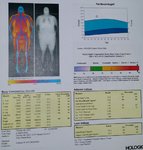
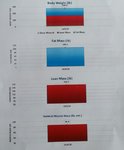
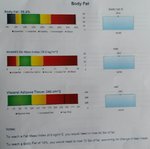
I'm not just fat - my lean mass is literally off the chart:
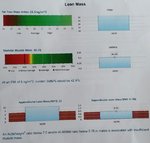
DXA estimated RMR and caloric needs are pretty close to my observed RMR of ~2150 & caloric needs of ~2350:
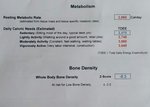
Obviously I'm still very fat, but I found it promising that my visceral fat wasn't as far out of range as general fat and that the ratio of my leg & trunk fat is almost normal (66th percentile vs 99+ percentile for overall body fat). Also surprising to see how little my skeleton weighs (<6 lbs)...
While there, I decided to do a VO2max test to compare with my fitbit:
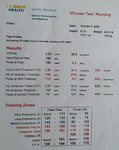
This was disappointing: 26 is poor for my age and fitbit has me at 33-37 (fair for my age). Excuses: I probably could have exerted a bit more effort (though my heart rate was already 180) and they increased resistance in 2 minute intervals so it took 10 minutes to get to the max effort and by then I was getting fatigued. I was also disappointed in my max wattage - 160 - as a competitive cyclist in my teens (ok 20 years ago) I seem to recall being able to doing well over 400 watts.
Still, if I was at a competitive race weight (140lb), with no other changes, my VO2 max would double and go from poor to excellent (I'm 38):

Neck Waist BF%
18.50 51.75 39.5%
18.25 52.25 40.4%
18.50 52.00 39.5%
18.75 52.00 39.8%
18.50 51.00 38.7%
18.75 51.25 38.7%
18.50 52.00 39.8%
DXA scan pretty much agreed & said 39.4%:



I'm not just fat - my lean mass is literally off the chart:

DXA estimated RMR and caloric needs are pretty close to my observed RMR of ~2150 & caloric needs of ~2350:

Obviously I'm still very fat, but I found it promising that my visceral fat wasn't as far out of range as general fat and that the ratio of my leg & trunk fat is almost normal (66th percentile vs 99+ percentile for overall body fat). Also surprising to see how little my skeleton weighs (<6 lbs)...
While there, I decided to do a VO2max test to compare with my fitbit:

This was disappointing: 26 is poor for my age and fitbit has me at 33-37 (fair for my age). Excuses: I probably could have exerted a bit more effort (though my heart rate was already 180) and they increased resistance in 2 minute intervals so it took 10 minutes to get to the max effort and by then I was getting fatigued. I was also disappointed in my max wattage - 160 - as a competitive cyclist in my teens (ok 20 years ago) I seem to recall being able to doing well over 400 watts.
Still, if I was at a competitive race weight (140lb), with no other changes, my VO2 max would double and go from poor to excellent (I'm 38):

